

Unknown
UnknownFl. Perianth and other petaloid segments in several whorls, broad in outline, sometimes squarish at apex, pure white, overlapping; the outer whorls spreading or a little inflexed; the inner whorls successively slightly shorter and more strongly inflexed; corona segments very small, in more than one sometimes near-continuous whorl among the petaloid segments at center, yellow, usually with red at rim, sometimes with a line of white between the yellow and the red. Strongly scented.
A description according to Daffodils, narcissus, and how to grow them as a hardy plants for cut… 1907 by Arthur Martin Kirby, when known as ‘Double Poeticus’: “It produces beautiful, large and fragrant double white flowers, which in purity, form and sweetness liken them to gardenias, for which reason it is often called the ‘Gardenia-flowered narcissus’. Botanically it is N. poeticus albus-plenus ordoratus and so is usually catalogued, though often with mystifying abbreviations. It thrives best in moist, loamy soil, often failing to flower in dry locations and it resents pot culture and forcing.”
A number of different double variants of N. poeticus have been recorded, but the identity of the original Poeticus ‘Plenus’ remains unclear. Two variants currently in cultivation are treated as ‘Tamar Double White’ and ‘Spalding Double White’; any other older names not known to be directly related to either of these are referred to Poeticus ‘Plenus’.
'Alba Plena Odorata', 'Albus Plenus Odoratus#', 'Double Border', 'Double Pheasant Eye', 'Double Poeticus', 'Flore pleno##', 'Gardenia', 'Patellaris Pleno Albo Cum Croceo', 'Plenus (poeticus)', 'Poeticus 'Flore Pleno'', 'Poeticus 'Plenus'', 'The Large Gardenia Flowered Double White Daffodil'
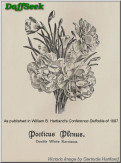 Plenus, 4 W-YYR, Unknown Hybridizer, 1861
Plenus, 4 W-YYR, Unknown Hybridizer, 1861
Photo #16730 Gertrude Hartland, Ireland Plenus, 4 W-YYR, Unknown Hybridizer, 1861
Plenus, 4 W-YYR, Unknown Hybridizer, 1861
Photo #12955 Hein Meeuwissen, the Netherlands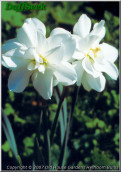 Plenus, 4 W-YYR, Unknown Hybridizer, 1861
Plenus, 4 W-YYR, Unknown Hybridizer, 1861
Photo #11379 Old House Gardens Heirloom Bulbs, USA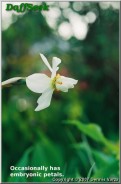 Plenus, 4 W-YYR, Unknown Hybridizer, 1861
Plenus, 4 W-YYR, Unknown Hybridizer, 1861
Photo #7896 Dennis Varza, USA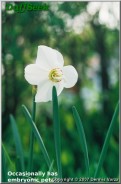 Plenus, 4 W-YYR, Unknown Hybridizer, 1861
Plenus, 4 W-YYR, Unknown Hybridizer, 1861
Photo #7895 Dennis Varza, USA Plenus, 4 W-YYR, Unknown Hybridizer, 1861
Plenus, 4 W-YYR, Unknown Hybridizer, 1861
Photo #7893 Hein Meeuwissen, the Netherlands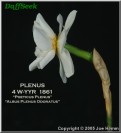 Plenus, 4 W-YYR, Unknown Hybridizer, 1861
Plenus, 4 W-YYR, Unknown Hybridizer, 1861
Photo #7890 Joe Hamm, USA Plenus, 4 W-YYR, Unknown Hybridizer, 1861
Plenus, 4 W-YYR, Unknown Hybridizer, 1861
Photo #7889 Joe Hamm, USA
![]()